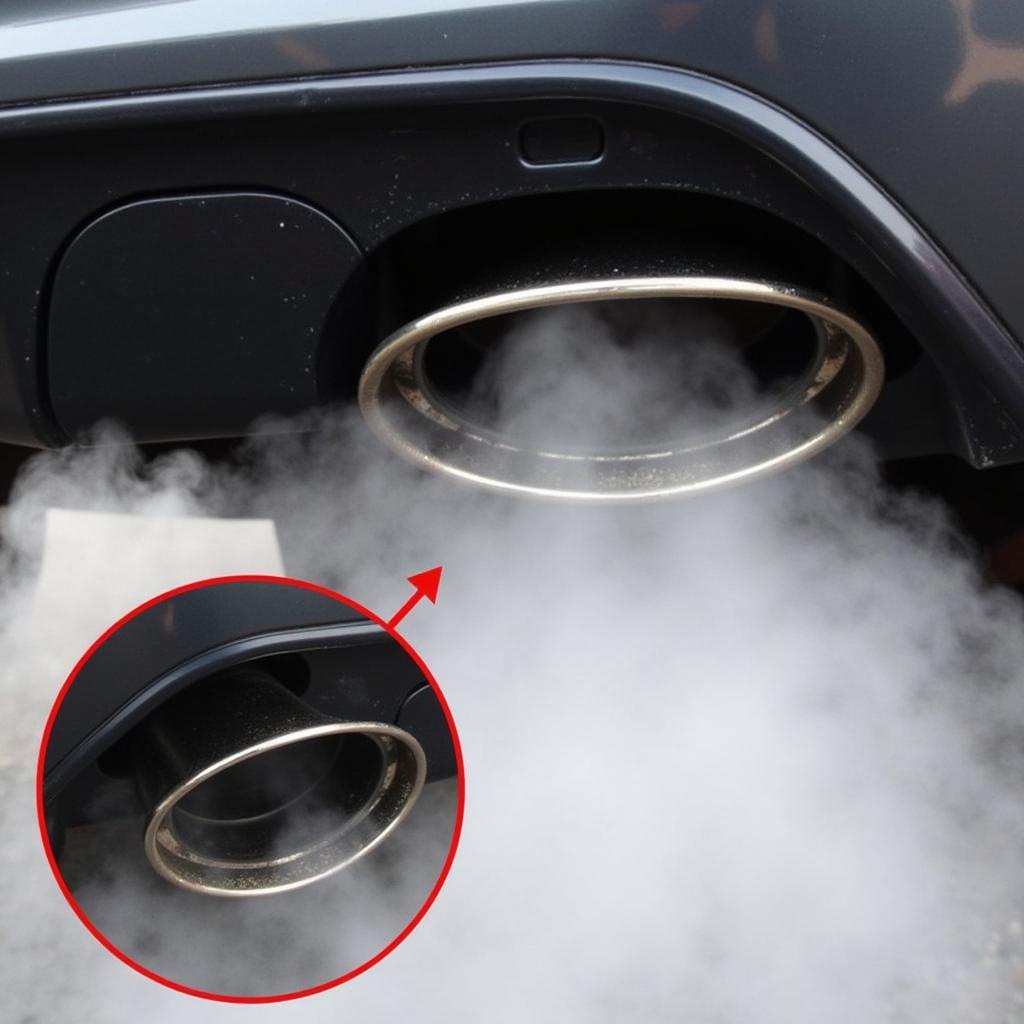If your car is puffing out gray exhaust smoke, you’re likely troubleshooting a tricky issue that can have several root causes. Understanding “how to fix car exhaust smoke gray color” requires a bit of detective work, but with the right approach, you can pinpoint the problem and get your car back on the road. This article will guide you through the process, from identifying the type of gray smoke to performing the necessary repairs.
What Does Gray Exhaust Smoke Mean?
Gray exhaust smoke is often a sign of oil burning in the combustion chamber or exhaust system. The shade of gray, from light to dark and even bluish-gray, can offer clues to the specific problem. It’s different from white smoke (often coolant) or black smoke (excess fuel), indicating a unique set of potential culprits.
Identifying the Shade and Cause of Gray Smoke
Light Gray Smoke
Light gray smoke can often be attributed to a minor oil leak, such as worn valve stem seals or a small leak in the PCV valve. This type of leak allows a small amount of oil to seep into the combustion chamber, resulting in a faint gray smoke.
 Light Gray Exhaust Smoke from Worn Valve Stem Seals
Light Gray Exhaust Smoke from Worn Valve Stem Seals
Dark Gray Smoke
Darker gray smoke suggests a more significant oil consumption issue. This could indicate worn piston rings, a damaged cylinder head gasket, or a faulty turbocharger (in turbocharged vehicles). The darker the smoke, the more severe the oil leak likely is.
 Dark Gray Exhaust Smoke from Worn Piston Rings
Dark Gray Exhaust Smoke from Worn Piston Rings
Bluish-Gray Smoke
Bluish-gray smoke typically indicates burning transmission fluid. This is usually caused by a leak in the transmission vacuum modulator or a cracked transmission housing. This is a serious issue that requires immediate attention.
Pinpointing the Source of the Leak
Several tests can help pinpoint the source of the oil leak:
- Compression Test: This test measures the pressure in each cylinder and can reveal issues with piston rings or valves.
- Leak Down Test: This test identifies leaks in the combustion chamber by introducing compressed air and measuring the leakage rate.
- PCV Valve Inspection: Check the PCV valve for clogs or damage.
- Visual Inspection: Look for obvious oil leaks around the engine and exhaust system.
How to Fix Gray Exhaust Smoke: A Step-by-Step Guide
- Diagnose the Problem: Use the information above and relevant tests to identify the root cause of the gray smoke.
- Gather Necessary Tools and Parts: Once you’ve diagnosed the problem, gather the necessary tools and replacement parts.
- Perform the Repair: Follow the appropriate repair procedures for the specific issue. This may involve replacing valve stem seals, piston rings, a cylinder head gasket, or other components.
- Test Drive and Monitor: After the repair, test drive the vehicle and monitor the exhaust smoke to ensure the problem is resolved.
“A thorough diagnosis is crucial. Don’t just throw parts at the problem. Understand the root cause before starting any repairs.” – David Miller, Automotive Engineer
Preventing Gray Exhaust Smoke
Regular maintenance is key to preventing gray exhaust smoke. This includes:
- Regular oil changes with the correct oil viscosity
- Checking and replacing the PCV valve as needed
- Monitoring fluid levels and addressing leaks promptly
“Preventive maintenance is always cheaper than major repairs. Stay on top of your car’s maintenance schedule to avoid costly problems down the road.” – Susan Carter, Certified Mechanic
Conclusion
Fixing gray exhaust smoke requires a systematic approach. By understanding the different shades of gray smoke and their potential causes, you can accurately diagnose the problem and take the necessary steps to fix it. Remember to prioritize preventative maintenance to avoid future issues. If you’re still having trouble, feel free to reach out to us at AutoTipPro for assistance. Contact us at +1 (641) 206-8880 or visit our office at 500 N St Mary’s St, San Antonio, TX 78205, United States. We’re here to help you get your car back in top shape.
FAQ
- Can I drive my car with gray exhaust smoke? It depends on the severity. Minor leaks might be tolerable for a short time, but significant oil consumption can lead to engine damage. It’s best to address the issue promptly.
- Is gray exhaust smoke always caused by burning oil? While oil is the most common cause, other issues, like transmission fluid leaks, can also cause gray smoke.
- How much does it cost to fix gray exhaust smoke? The cost varies depending on the underlying cause and the necessary repairs. It can range from a simple PCV valve replacement to a more complex engine rebuild.
- How can I prevent gray exhaust smoke in the future? Regular maintenance, including oil changes and fluid checks, is crucial for prevention.
- What if the gray smoke persists after repairs? If the smoke persists, it’s possible that the initial diagnosis was incorrect, or there might be another underlying issue. Seek professional help for further diagnosis.
- Is it safe to DIY repair gray exhaust smoke issues? If you have mechanical experience, you might be able to handle some repairs. However, more complex issues are best left to professionals.
- What tools do I need to diagnose and fix gray exhaust smoke? The required tools vary depending on the specific problem. Common tools include a compression tester, leak down tester, socket set, and wrenches.





Leave a Reply